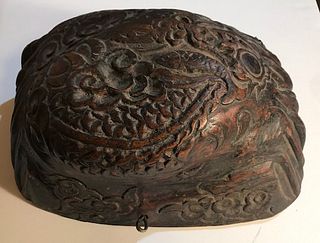Japanese Meiji Gilt Wood Zushi Shrine w/ Bodhisattva
Lot 92e
About Seller
Artemis Gallery
686 S Taylor Ave, Ste 106
Louisville, CO 80027
United States
Selling antiquities, ancient and ethnographic art online since 1993, Artemis Gallery specializes in Classical Antiquities (Egyptian, Greek, Roman, Near Eastern), Asian, Pre-Columbian, African / Tribal / Oceanographic art. Our extensive inventory includes pottery, stone, metal, wood, glass and textil...Read more
Categories
Estimate:
$1,200 - $1,800
Absentee vs Live bid
Two ways to bid:
- Leave a max absentee bid and the platform will bid on your behalf up to your maximum bid during the live auction.
- Bid live during the auction and your bids will be submitted real-time to the auctioneer.
Bid Increments
| Price | Bid Increment |
|---|---|
| $0 | $25 |
| $300 | $50 |
| $1,000 | $100 |
| $2,000 | $250 |
| $5,000 | $500 |
| $10,000 | $1,000 |
| $20,000 | $2,500 |
| $50,000 | $5,000 |
| $100,000 | $10,000 |
| $200,000 | $20,000 |
About Auction
By Artemis Gallery
Aug 27, 2020
Set Reminder
2020-08-27 10:00:00
2020-08-27 10:00:00
America/New_York
Bidsquare
Bidsquare : VARIETY SALE | Antiquities & Ethnographic Art
https://www.bidsquare.com/auctions/artemis-gallery/variety-sale-antiquities-ethnographic-art-5477
Around the world & back in time - be amazed at the treasures you will find. Antiquities from Egypt, Greece, Italy and the Near East, Asian, Pre-Columbian, African / Tribal / Oceanic, Native American, Spanish Colonial, Russian Icons, Fine Art, much more! Artemis Gallery info@artemisgallery.com
Around the world & back in time - be amazed at the treasures you will find. Antiquities from Egypt, Greece, Italy and the Near East, Asian, Pre-Columbian, African / Tribal / Oceanic, Native American, Spanish Colonial, Russian Icons, Fine Art, much more! Artemis Gallery info@artemisgallery.com
- Lot Description
East Asia, Japan, early Meiji, ca. 1880 CE. A finely carved and gilded wooden zushi (a petite Buddhist shrine) portraying a Bodhisattva standing atop a lotus blossom. The gilding on this piece is extensive - 70% gold on the pedestal base; 80% gold on the interior doors; and gilded copper on the exterior doors. The figure presents with a peaceful visage adorned by a floral headdress and is dressed in flowing robes. In addition, the level of detail on this piece is very impressive. Buddhist statues in Japan frequently reside in such zushi - wooden shrines with doors that can both reveal or conceal the deity within. Some scholars trace this Japanese interpretation of a Buddhist practice to Shinto shrines, where it is rare to find a statue, and they are always concealed. Size (figure): 4.875" W x 15.5" H (12.4 cm x 39.4 cm); (shrine): 6.5" L x 8.4" W x 17.875" H (16.5 cm x 21.3 cm x 45.4 cm). Gilding quality: 70% gold (between 15K and 18K)on the pedestal base beneath the figure; 80% gold (over 18K) on interior doors; exterior doors are gilded copper.
At the start of the Meiji Period (1868), the Japanese government declared that Buddhism must be separated from Shinto, the official state religion. Initially, enforcement of the separation was strict, and Buddhist images were stricken from many Shinto shrines. Within a few years, however, enforcement stopped and Buddhist images crept back into Japanese religious art. A shrine like this one, depicting a Bodhisattva was created during this time period.
Provenance: private southern California, USA collection, acquired before 2000
All items legal to buy/sell under U.S. Statute covering cultural patrimony Code 2600, CHAPTER 14, and are guaranteed to be as described or your money back.
A Certificate of Authenticity will accompany all winning bids.
We ship worldwide and handle all shipping in-house for your convenience.
#157244Figure reattached at ankles, with repairs to right arm at elbow, areas of ovoid backing, and bottom of lotus pedestal just above tiered base, with small chips and light adhesive residue along break lines. Losses to left arm at elbow, fingers on right hand, and areas of ovoid backing as shown. Chips to figure, base, doors, and shrine exterior, with light encrustations within some recessed areas. Great remains of gilding and patina throughout.Condition
- Shipping Info
-
All shipping is handled in-house for your convenience. Your invoice from Artemis Gallery will include shipping calculation instructions. If in doubt, please inquire BEFORE bidding for estimated shipping costs for individual items.
-
- Buyer's Premium



 EUR
EUR CAD
CAD AUD
AUD GBP
GBP MXN
MXN HKD
HKD CNY
CNY MYR
MYR SEK
SEK SGD
SGD CHF
CHF THB
THB















